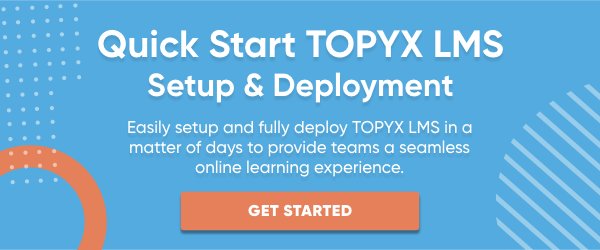It’s vital for companies that use online learning tools like a learning management system (LMS) to implement a performance evaluation system that can deliver feedback to employees on the progress they are making on their remote training program. A performance evaluation system is defined as “a systematic way to examine how well an employee is performing in his or her job. If you notice, the word systematic implies the performance evaluation process should be a planned system that allows feedback to be given in a formal—as opposed to informal—sense.”1
Online learners need feedback from a performance evaluation system because they help companies keep a pulse on remote training performance, promote career development, and ensure staff members get recognized for their training achievements. Performance evaluation systems are particularly helpful to companies with remote employees since staying in touch with and evaluating the performance and productivity of those who work from home can be challenging without an established system in place.

How to create a performance evaluation system for remote employees
Due to the COVID-19 pandemic, many companies are managing a dispersed workforce. For these organizations, eLearning has been a lifesaver since it can be accessed from anywhere. Here’s how company leaders can create a performance evaluation system for employees:
1. Assemble an evaluation form
A performance evaluation form is a crucial aspect of a performance evaluation system and is simple to create. The form should include the employee’s name, job title, and department, then list the training course or courses the learner is being evaluated for. After this preliminary information, write a subheading such as “Performance Factors” and make a list beneath it that details these factors. Consider including engagement with training, cooperation with online instructors, and course completion rates.
Since it’s advisable to review learners fairly often, it’s best to keep evaluation forms relatively short. Create a more thorough form for a yearly or bi-yearly performance review. This form should be completed by employees’ eLearning course instructors and/or managers who are involved in their training process.
Related reading: How eLearning Tools Enable Remote Training During the COVID19 Pandemic
2. Create a learner feedback form
It’s important to give learners a voice by getting their feedback on the learning experience. “A good feedback system is where both the learner and the instructor interact frequently,” wrote a contributor to eLearningIndustry.com. “If the system is 1-way (the instructor provides continuous feedback only), important learner's concerns might be overlooked or completely ignored.”2 A learner feedback form could ask employees:
- How engaging specific online courses were
- What they had trouble understanding about a course
- Where in a course they dropped out or considered dropping out
- How they feel about the feedback from instructors/managers during their last performance review
- What type of eLearning courses they’d like to take in the future
- How they think the company could improve its online learning program
Learner feedback forms should be delivered to instructors and managers after being completed by employees. Company administrators should consider collecting feedback from learners as often as they review employees’ training performance.
3. Set an evaluation schedule
After you’ve created an evaluation form and a learner feedback form, it’s time to set an evaluation schedule. Some companies evaluate learners just once per year, but this won’t provide the most accurate results. It’s generally a much better idea to evaluate learners every few weeks and to gather their feedback after they have read their evaluations and/or completed an online course or training program. In fact, you may want to consider giving learners a small amount of continuous feedback on their training progress so that they aren’t surprised by the results of their evaluations at the end of a course.
Use an LMS to create and manage your company’s performance evaluation system
Feeling overwhelmed by the prospect of assembling an effective performance evaluation system for your dispersed workforce? A learning management system (LMS) can help. An LMS like TOPYX features content creation tools that enable you to create performance evaluation materials and social learning tools that allow you to share those materials with instructors, managers, and learners.
Additionally, TOPYX features LMS reporting. This feature gives you an inside look at the progress individual employees are making in their eLearning courses. LMS reporting enables administrators to easily navigate reports in an intuitive and customizable dashboard that provides a comprehensive overview of key performance indicators. This feature also gives learners access to their reports cards, transcripts, and competencies, keeping them updated on their learning progress.
If you are ready to inspire workers to level up their learning habits and gain the skills needed to succeed at work, you’ll need an engaging performance evaluation system. To create, deliver, and manage one in-house, request an LMS demo of the TOPYX platform. And with our Quick Start Program, you can deploy the learning management system in a matter of days.
References:
1. https://open.lib.umn.edu/humanresourcemanagement/chapter/11-1-performance-evaluation-systems/
2. https://elearningindustry.com/performance-reviews-or-continuous-feedback-right-approach-learner-evaluation-engagement








